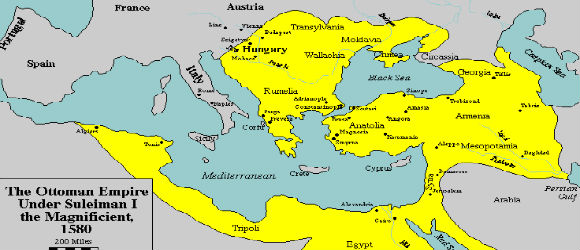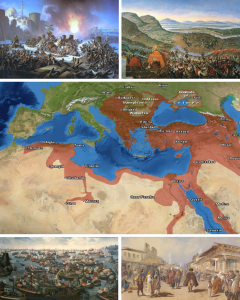The Ottomans created the greatest and most powerful State in Turkish history. In the reign of Murat III (1574- 1595) the Ottoman Empire extended over an area of some 20 million sq km. in three continents. The origins of the Ottomans go back to one of the principalities founded after the destruction of the Seljuk State by the Mongols. This principality had been established by the Kayi tribe, a member of the Oğhuz confederation of Turkish tribes.
The Ottoman principality lay in the district of Soğut and Bilecik in western Anatolia and was first ruled by Ertuğrul Gazi. The latter’s son Osman (from whom the name Ottoman is derived) extended his frontiers to the sea of Marmara in the west and the Black Sea in the north. Then under Orhan Gazi, the whole triangle bounded by the Aegean, the sea of Marmara and the Black Sea fell to the Ottomans, who also crossed over into Europe. It was at this time that the Byzantines lost their important fortresses at İzmit and İznik. In the east, the Ottomans made themselves masters of Ankara, thus taking the first step towards the reunification of Anatolia.
Then 1354 saw another turning point in Turkish history, when Turks crossed the Dardanelles, set foot in Europe and established themselves in Gelibolu (Gallipoli). Sultan Murat I threw himself heart and soul into the European venture, and between 1354 and 1389 the Ottomans advanced from Gelibolu to Kosovo (now in Yugoslavia) and became the paramount power in the Balkans. Crusading armies took the field against the Ottomans but were defeated one by one. Then under Sultan Yıldırım Bayezıt (the Thunderbolt) the Ottomans threw their entire force into Asia.
Much of Anatolia – to the Taurus mountains and the Euphrates – fell into their hands. In Europe another Crusading army was defeated at the battle of Nicopolis. The Byzantines were unable to stem the Ottoman tide, but a new threat arose in the east and Sultan Bayezıt was defeated near Ankara by another Turkish sovereign, Timur (Tamerlane), lord of the eastern Turks. This defeat shook the Ottoman State to its foundations, shattered once again the unity of Anatolia, and delayed the final emergence of the Ottoman Empire by half a century. Between the battle of Ankara and the conquest of Istanbul (1402-1453), the Ottomans devoted their energy to reestablishing the frontiers first achieved by Yıldırım Bayezıt. In 1451, when Mehmet II (surnamed Fatih, i.e. the Conqueror) ascended the throne, the Ottoman state found itself in possession of powerful resources.
The conquest of Istanbul ushered in a new advance which continued for almost a century and a half until 1595. The area of Ottoman dominions which amounted to some 2 million sq km. at the death of the Conqueror, reached 20 million sq km. in the reign of Murat III. In this new age of conquests, the Crimea was added to the Empire which stretched to the southern approaches of Moscow.
The Ottoman conquest of Anatolia was consolidated :
After the conquest of Trabzon (Trebizond) in 1461, the entire peninsula became a Turkish and a Muslim land. The whole of Greece too was conquered, and both the Aegean and the Black Sea became Ottoman lakes. Under Sultan Yavuz Selim the area of the Empire trebled. Its frontiers were extended to Ethiopia, central Africa and the Indian Ocean. After his conquest of Egypt, Yavuz was recognised as the strongest Islamic sovereign, the unrivalled representative of Islam. The Empire reached the zenith of its power under Süleyman the Magnificent (known in Turkish as Kanuni or the Lawgiver) in the 16th century.
In the following 88 years (1595-1683) the Ottomans not only suffered no territorial losses, but even rounded off their conquests. At times (as under Murat IV and when the Köprülü family were in power as Grand Viziers), the Empire seemed to relive the splendour which it had achieved under Süleyman the Magnificent. But this external appearance was deceptive : The seeds of disintegration were attacking the inner structure of the State with results which became evident in the following century. Disaster struck the Empire between 1683 and 1699. In the sixteen years which followed the failure of the second Ottoman attempt to storm European States. Under the treaty of Carlowitz it conceded defeat, losing Poland, Hungary and Transylvania.
Nevertheless, the Ottomans recovered and reestablished their position as the strongest single power in the area until 1768. Some of the territories ceded at Carlowitz were regained, and certain internal reforms undertaken. However, reform did not touch the organisation that was most in need of it-the military corps of the Janissaries. This was the cause of the Ottoman defeat in the war fought with Russia between 1768 and 1774. Between 1768 and 1838 under Sultans Abdülhamlt I. Selim III and Mahmut II a determined attempt was made to modernise the Ottoman state. There was indeed much to reform : The Empire had remained a medieval power while Europe had forged forward; internal cohesion was shaken by the emergence of a number of semi – independent war – lords. At one time a self – sufficient State with a surplus to export, the Ottoman Empire had begun to rely on imports from Europe. Mahmut II swept away the war-lords, reestablished the authority of the central government, undertook a number of economic reforms, and, while failing to achieve European standards, ensured the continued existence of the Empire in three continents for another century.
More extensive reforms were undertaken between 1839 and 1876 by two sons of Mahmut II, the Sultans Abdülmecit and Abdülaziz. Great reforming statesmen, such as Reşit. Âli and Fuat Pashas were put in charge of the administration. More efforts were made to catch up with Europe, but an impoverished treasury was unable to provide the financewhich this required. So the Empire remained dependent on the European powers which coveted its wide territories. This weakness led to the Ottoman defeat in the war with Russia in 1877 to 1878.
However, efforts at reform continued. Leading intellectuals and statesmen such as Midhat Pasha, Ziya Pasha and the poet Namık Kemal became the standard – bearers of the struggle for freedom. The reformers known in Europe as Young Turks deposed the Sultan Abdülaziz in favour of Murat V. However, three months later he too was deposed to be succeeded by Abdülhamit II who promised to introduce a Constitution. The Constitution was in fact proclaimed on 23 December 1876 and Midhat Pasha was made Grand Vizier, but the Sultan then used the defeat suffered at the hands of the Russians as a pretext for proroguing Parliament.
Between 1876 and 1908 the Empire was ruled arbitrarily by Abdülhamit II as an absolute ruler. Decline continued, and provinces such as Bosnia-Herzegovina, Tunisia and Cyprus were lost. Worse was to follow. The Constitution was once again put into operation in 1908, but the Party of Union and Progress which acquired power helped only to hasten the decline. The Empire which stretched over 9 million sq kms. in three continents was collapsing. Foreign communities and minorities, supported by the Great Powers of Europe, sought to secede from the dying State. After the Balkan Wars (1912-1913) the Ottoman frontier fell back from the Adriatic to the Meriç (Maritza) river.
Ottoman Empire,

